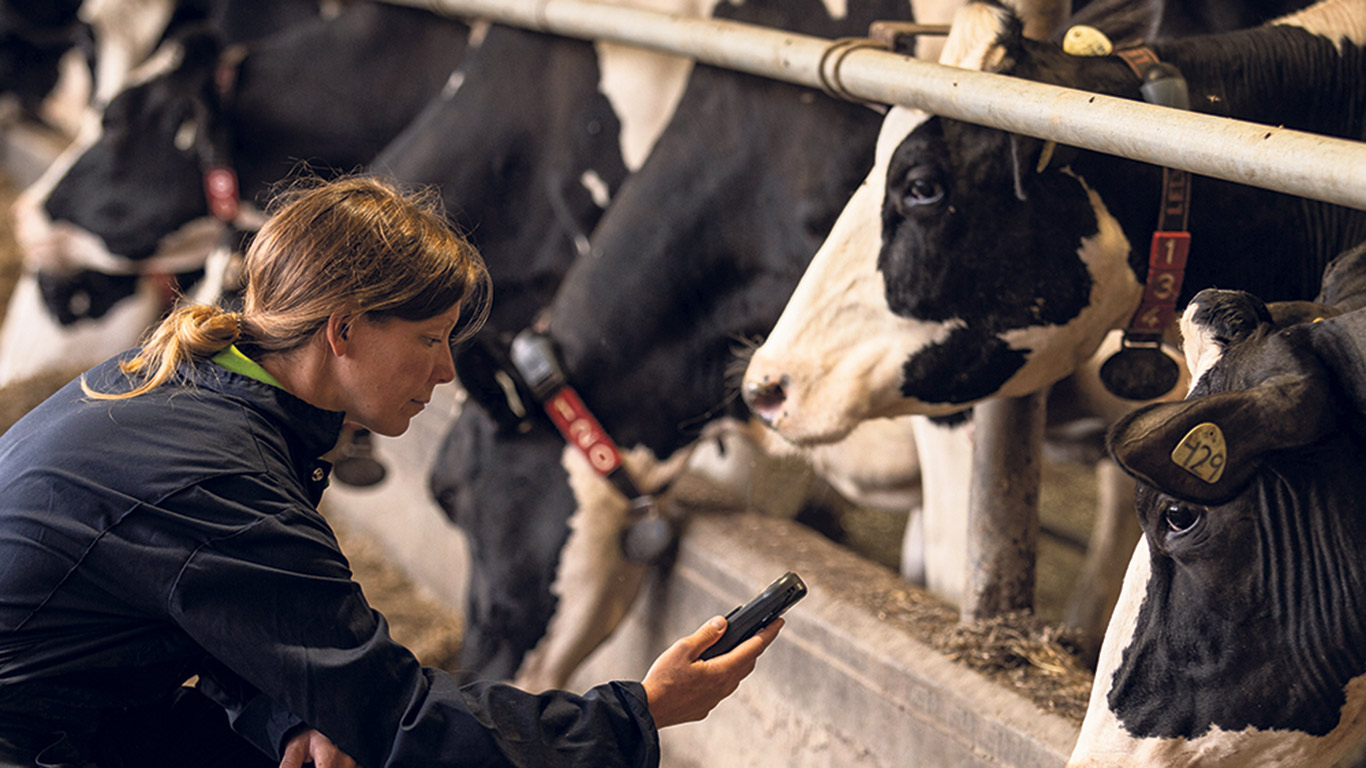
Aug 2024
Through the Agricultural Methane Reduction Challenge organized by Agriculture and Agri-Food Canada, Agropur wants to develop a dry-extruded flaxseed-based feeding strategy that could reduce methane emissions from dairy cows by at least 9.2%.
In July, this idea earned Agropur a spot among the challenge’s 13 semi-finalists out of 86 applications received. The instigator of the project at Agropur, agronomist Sophie Neveux, who holds the title of Head of Sustainable Agriculture, is excited by the feeding strategy she is developing.
“We think it is an innovative solution that will be interesting for dairy producers, because it replaces an ingredient already in the ration. It is not an addition, but a replacement.”
Sophie Neveux
Sophie specifies that the literature already documents the benefits of rations based on flax seeds, rich in omega-3, on the health, animal welfare and milk yield of cows. However, there were indications that it also helped reduce enteric methane emissions. The flax is produced in Canada and the commercial ingredient – obtained through a dry extrusion process using pressure and heat to modify the structure of the seeds’ proteins and make them more digestible for animals – is already patented by Agropur’s partner, O&T Farms in Regina, Saskatchewan. “So it’s not the ingredient that’s innovative,” she says, “but the feeding strategy containing this commercial ingredient.”
A 2008 scientific report estimated a methane reduction of 15 to 40 per cent. Another from 2023 came to a reduction of about 9.2 per cent.
In July, 13 selected semi-finalists each received $153,000 to write an implementation plan for their project. If they qualify for the next stage, they will receive up to $230,000 in funding in the spring of 2025 to implement the solution.
For Agropur, this would mean funding a research project at Université Laval’s experimental dairy farm. The farm is equipped with GreenFeeds, devices that cows pull their noses into to feed and that capture the amount of methane exhaled. “We will provide percentages of this flaxseed extrusion in the dairy cow’s feed and see the reduction in methane that we will be able to measure concretely,” says Ms. Neveux. She intends to test rations at 0%, 2.5%, 7.5% and 10% of the commercial ingredient, which is similar to a mixture of crushed flaxseed, in the dry matter intake.
At the same time, the project aims to create an algorithm that could be included in milk producers’ carbon footprint tools. “It could be an option in the drop-down menu that the producer can select to say: ‘This year, I did something new and additional. I included flax seed extrusion in my ration at rate X and therefore, the methane reduction calculation will be done automatically,’” explains the agronomist.
To this end, Agropur will work with Logiag, a carbon footprint service provider in Montérégie, to develop the algorithm. This, she believes, will make life easier for producers who will use the solution on the farm. The research project also includes a cost and return on investment analysis for the producer.
On-farm tests in 2026
In the third stage of the challenge, in the spring of 2026, the 10 finalists selected will be awarded an amount of up to $500,000. If selected, Agropur will then test the solution with dairy producers who are members of the cooperative. A carbon footprint will be conducted on participating farms before the ingredient is included and another after to continue to demonstrate that the ingredient works. Working with nutritionists and producers, she will assess the viability, feasibility and ease of the solution on the farm.
Agropur will also analyze the effects of flax on the milk produced. “We wonder if there are other benefits that could be interesting for us, as a dairy processor,” says Sophie Neveux. “Will milk or dairy products have an interesting behavior or profile for consumers? That’s also part of our investigation with the challenge.”
The grand finale in 2028
At the end of 2028, the two finalists with the most impressive results will be awarded an amount of up to $1 million each. If Agropur’s adventure and its partners was to end before, Sophie Neveux does not rule out seeking funding elsewhere to complete the project.
Other Quebec initiatives in the running
Two other Quebec solutions caught the attention of the judges of Agriculture and Agri-Food Canada’s Agricultural Methane Reduction Challenge in July. Université Laval in Quebec City is working on a biofiltration concept, which consists of transforming methane in the air into carbon dioxide and water vapour using an organic substrate containing bacteria.
Mon Système Fourrager in Montreal helps producers adopt enteric methane reduction strategies using a forage system decision-making tool.
It should also be noted that the Semex Alliance in Guelph, Ontario, of which Lactanet is a partner, is focusing on genetic selection of cattle to reduce enteric methane emissions.
Semex proposes to develop a selection protocol for genetic traits associated with low methane production and an incentive strategy to encourage breeders to integrate them into their herds. Semex also seeks to evaluate the results over time.
Photo courtesy of Agropur





